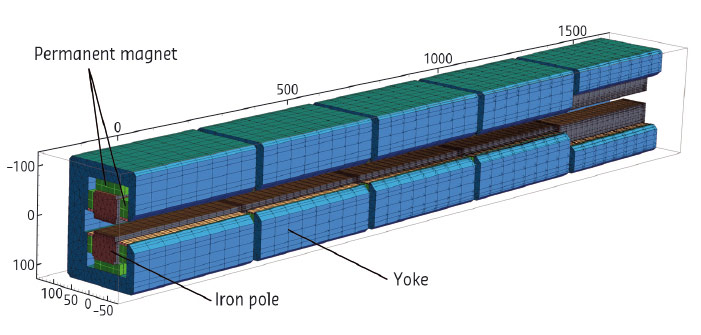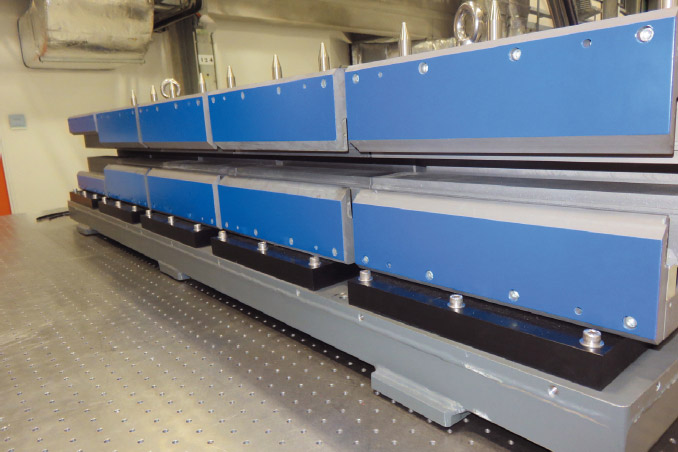- Home
- Users & Science
- Scientific Documentation
- ESRF Highlights
- ESRF Highlights 2016
- Enabling technologies
- Longitudinal gradient dipole magnets for the ESRF-EBS storage ring
Longitudinal gradient dipole magnets for the ESRF-EBS storage ring
The new magnet lattice of the ESRF-EBS will need an ensemble of 128 dipoles with longitudinal gradient. Due to the specificity of their magnetic field, these dipoles will be built with high performance permanent magnets. Their assembly and magnetic characterisation will take place at the ESRF.
The electron beam of the ESRF-EBS storage ring will have a horizontal emittance 30 times smaller than the existing storage ring. This major step forward requires new magnet designs. Besides the development of high gradient quadrupoles and sextupoles, the design of the bending magnets needed to evolve considerably from the conventional dipole structure due to the specific geometrical distribution required for the magnetic field. Consequently, the new lattice will comprise new types of combined-function bending magnets: 96 combined dipole-quadrupole bending magnets and 128 dipoles with longitudinal field gradient. The dipoles will be based on high performance permanent magnets. They will be assembled and magnetically characterised/tuned at the ESRF.
The magnet field of the dipole magnets varies along the electron beam path, from 0.65 T to 0.17 T over a distance of 1.784 m. The concept of a continuous field variation was found impractical due to the resulting magnetic complexity and also for economic reasons. The best approach was to segment a dipole into several almost independent modules with different fields. In practice, each dipole is segmented into 5 modules of about 0.35 m each. From initial studies in 2012-2013, permanent magnets appeared to be the best solution for such magnetic structures because of their compactness, adaptation to segmentation and ease of installation (no need for electrical power). In addition, the ESRF has long-standing experience with permanent magnets through the development of insertion-devices. We predict that the use of permanent magnets in accelerators will grow significantly in the near future due to the demand for high performance and compact magnets [1].
 |
|
Fig. 147: 3D magnetic model of a dipole magnet. |
Figure 147 shows the 3D magnetic design of a dipole with 5 modules with a pole to pole separation of 4 mm. Magnet blocks of type Sm2C017 are sandwiched between an iron pole and a low carbon steel C-shape yoke. The successive modules have a different number of magnet blocks to achieve a step-like field variation along the structure. The high field module (0.65 T) on the left is entirely filled with 36 magnet blocks while the low field module (0.17 T) on the right has only 8 magnet blocks. The low field module has a modified yoke to allow the integration of dedicated vacuum components. In total about 100 magnet blocks are needed for one complete dipole. For all 128 dipoles, it will be necessary to build 12800 magnet blocks, corresponding to 6 tons of Sm2C017. This material was found the most suitable in order to achieve a low dependence upon temperature and an excellent long-term stability against radiation-induced demagnetisation. The temperature stability of the magnets is further improved with the use of flux shunts made of a special iron-nickel alloy with a Curie temperature of 60°C.
 |
|
Fig. 148: Dipole modules assembled on a base plate. |
The engineering design of the dipoles required substantial efforts in many aspects of the project. This included the procurement and control of the high quality iron needed to reach the field quality, the selection and follow up of subcontractors for the precise machining of the iron blocks and the delivery of assembled empty modules (without permanent magnet blocks). Special assembly benches have been developed to mount the permanent magnet blocks in the modules. Figure 148 shows the assembly of the 5 modules of a dipole. The modules are mounted on a base plate along a curved path corresponding to the electron beam trajectory in the magnet; the angular defection induced by a dipole is about 30 mrad. An important task was to control the magnetic forces between the modules during their assembly. Several important technological developments were needed to prepare and set up the construction of the dipole series.
The assembly and magnetic characterisation of the 128 dipoles will be carried out over a period of one year. All the modules (640 units) will be carefully measured with an accurate magnetic measurement system developed specifically for the ESRF-EBS magnets. The magnetic field of each module will need to be accurately tuned to the design value using thin iron flux shunts. The construction of two complete dipoles was started in mid-November. The first magnetic measurements show very good agreement with simulations and we are optimistic for the remaining steps in the development of these magnets.
Authors
C. Benabderrahmane, J.Chavanne, G. Le Bec, L. Eybert, C.Penel, D. Gibson and F. Villar.
ESRF
References
[1] J. Chavanne and G.Le Bec, IPAC 14, Dresden Germany (2014).



